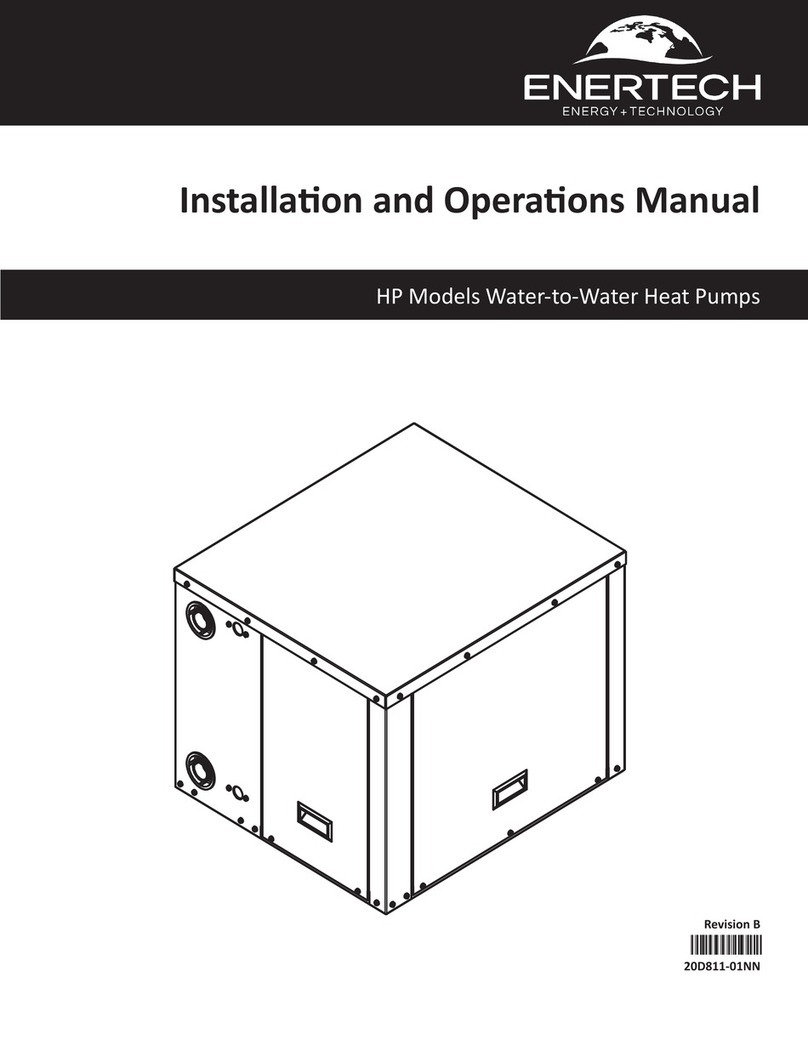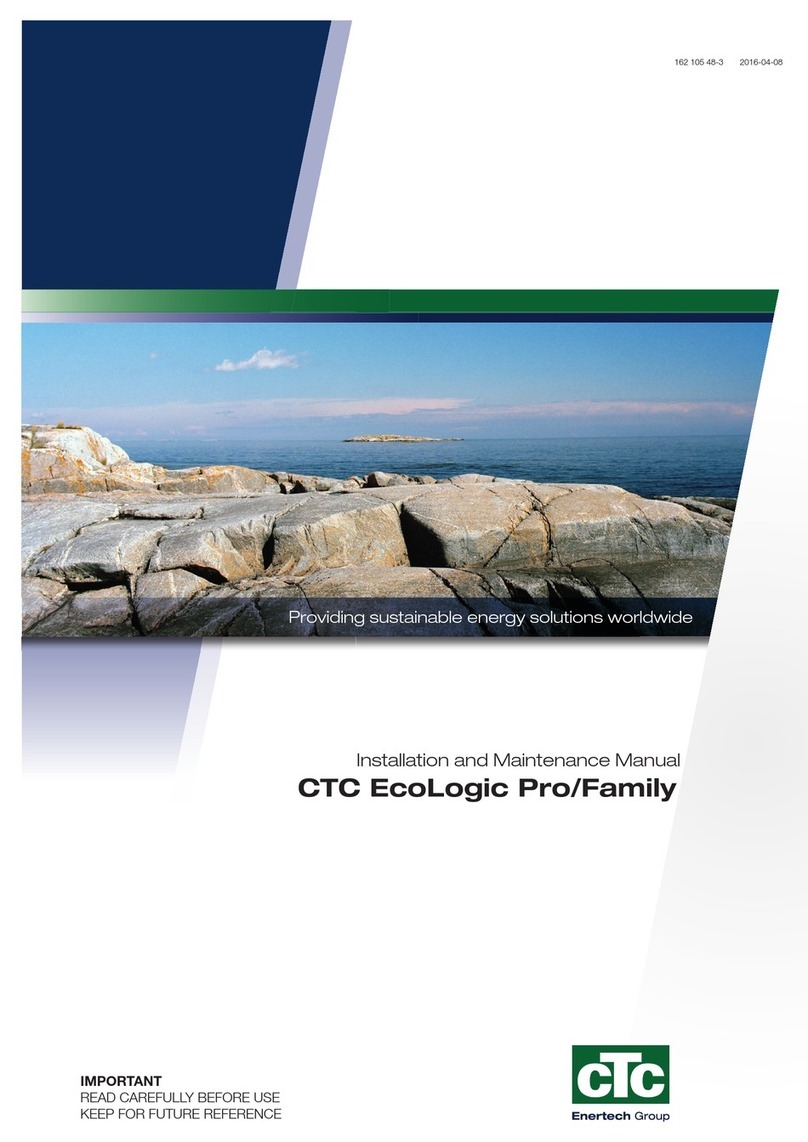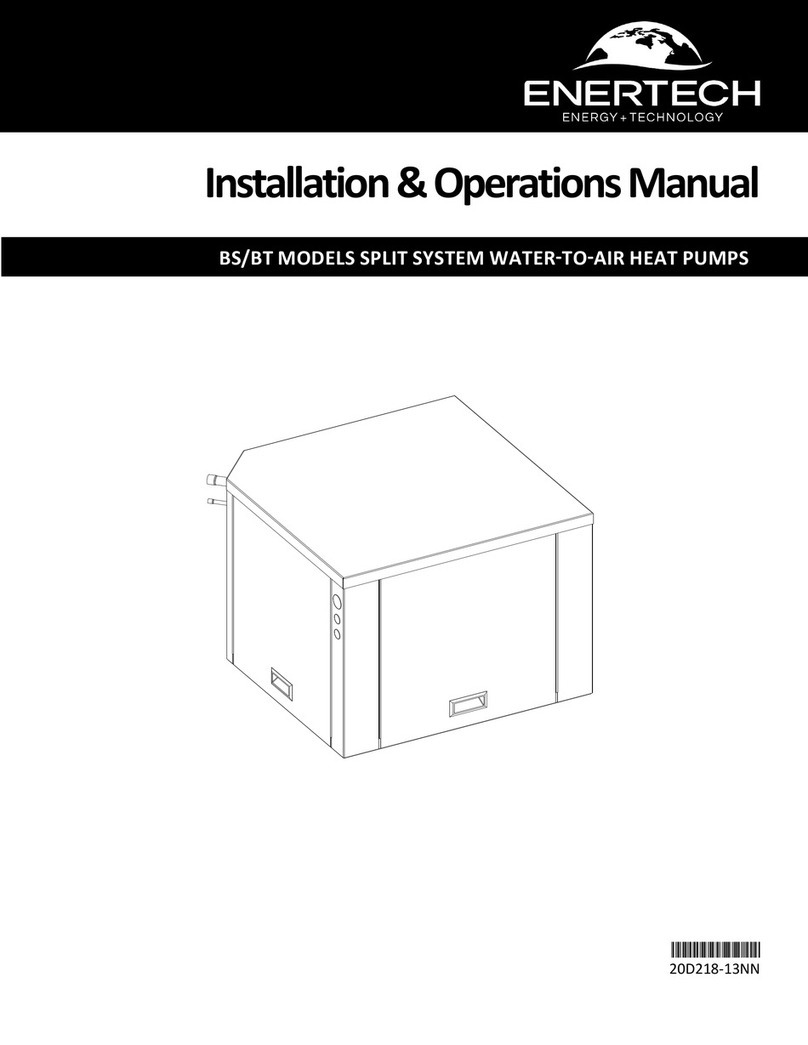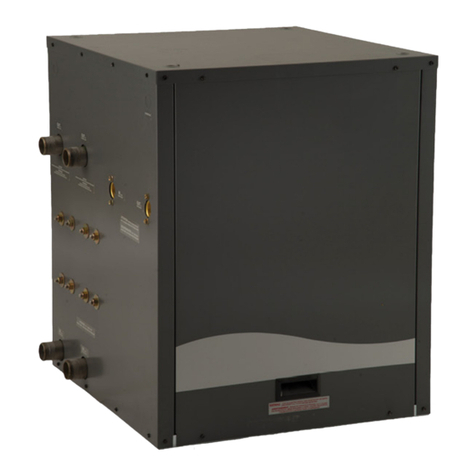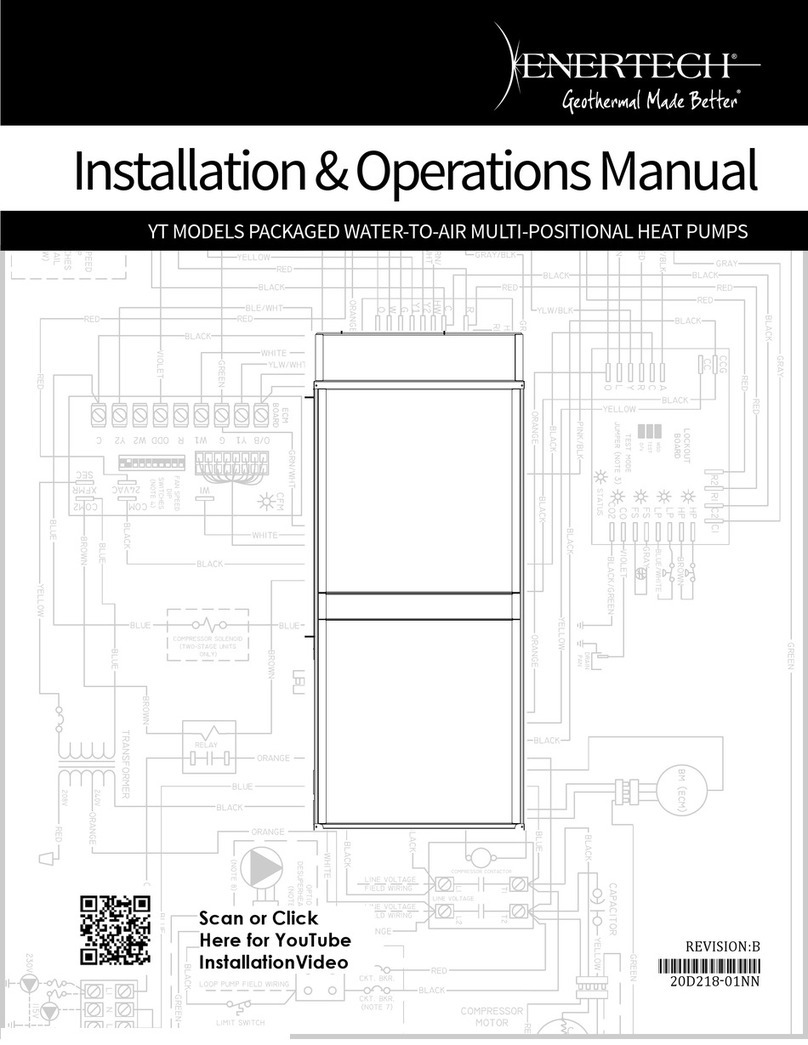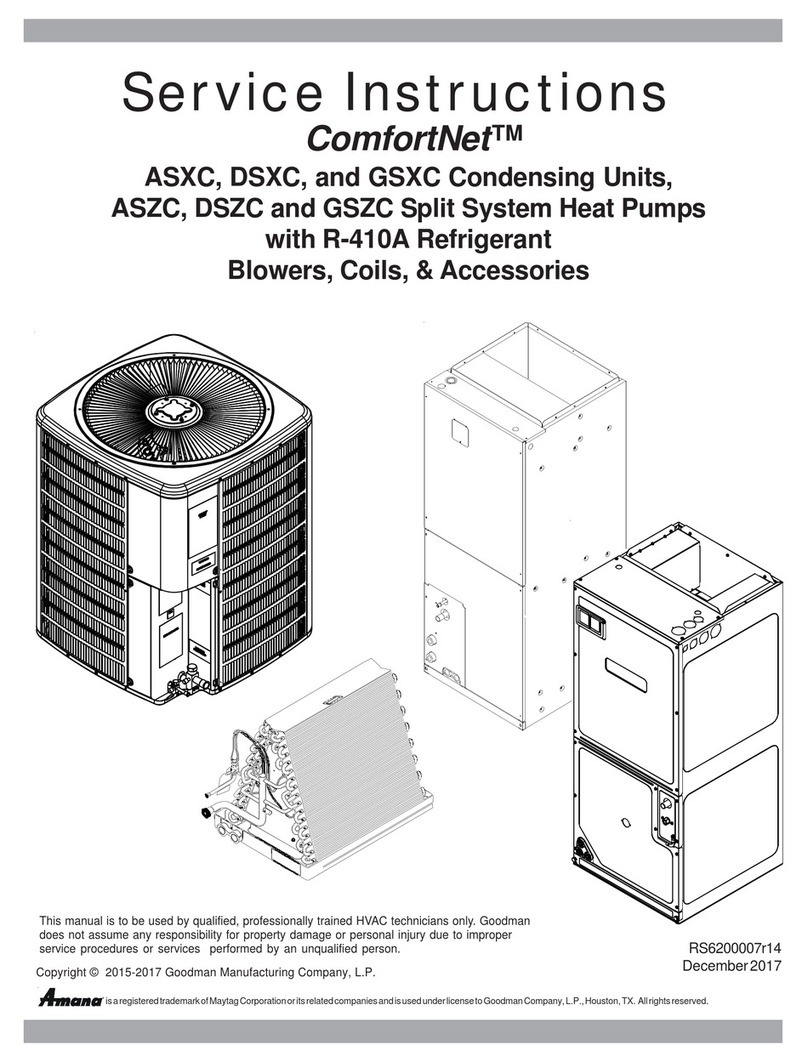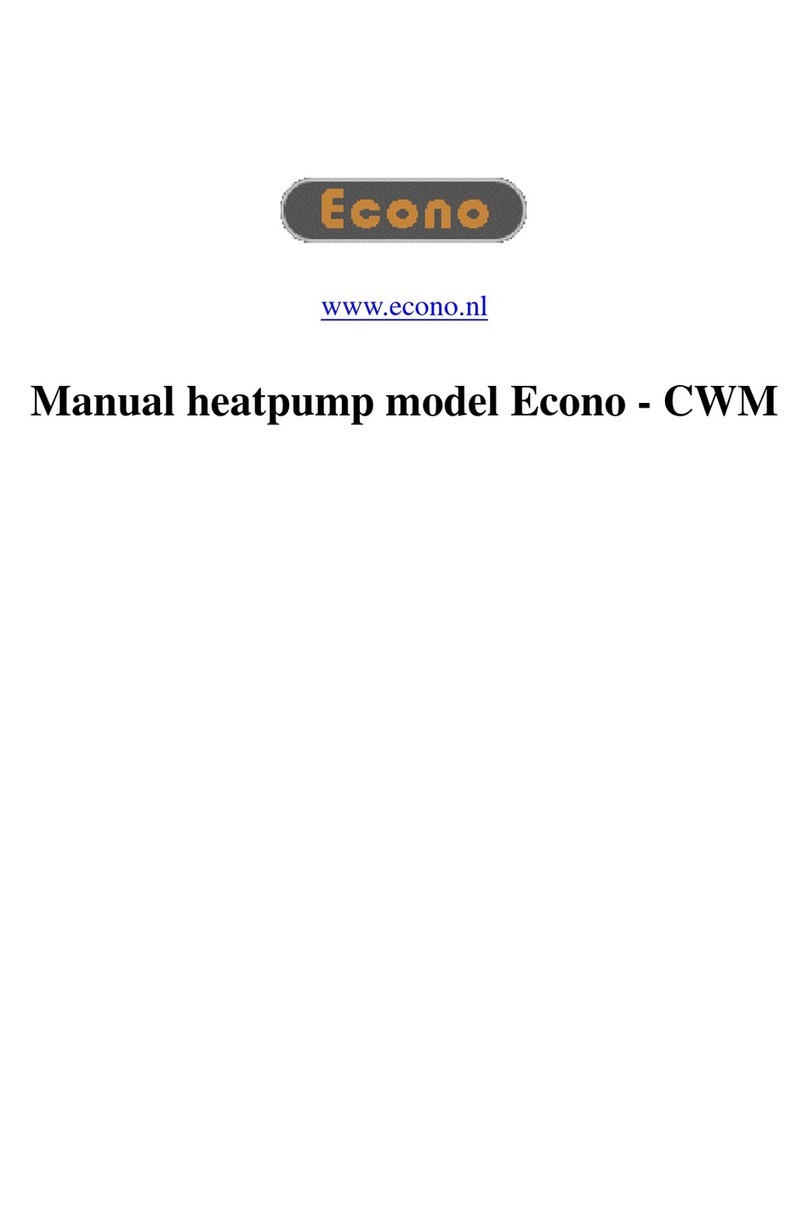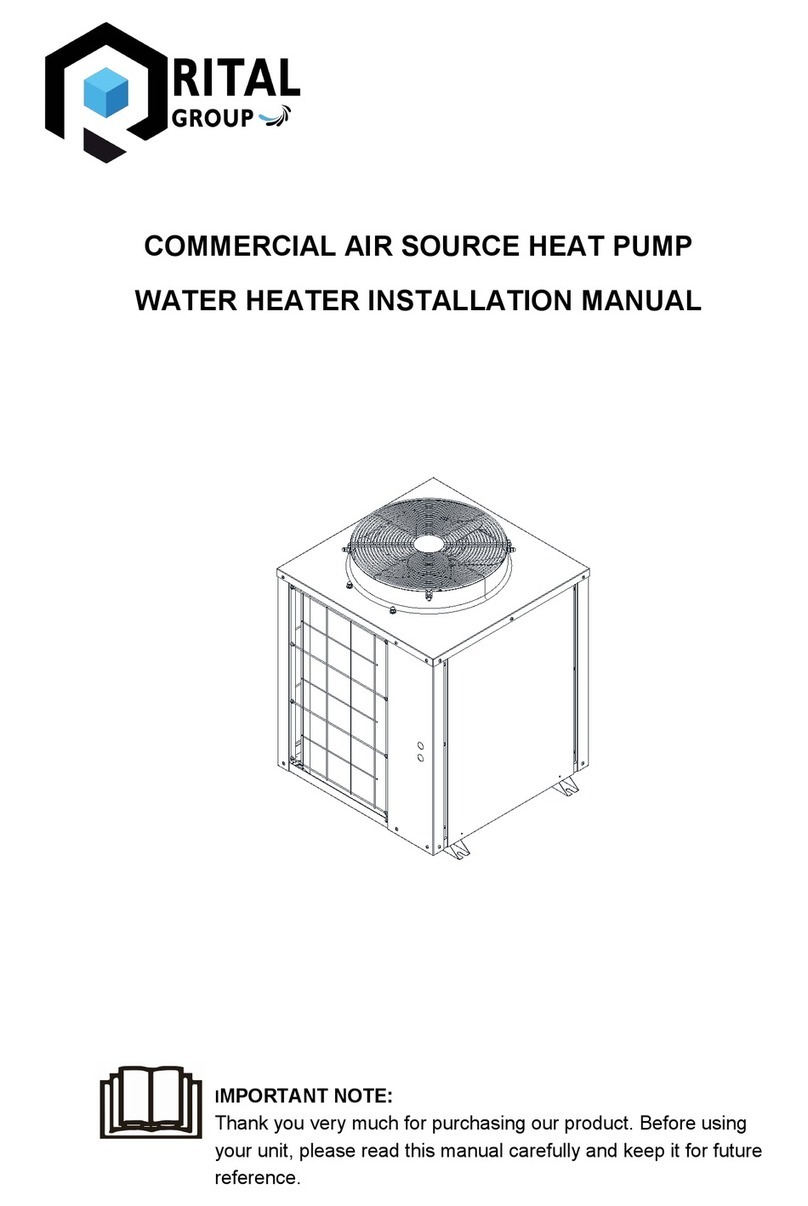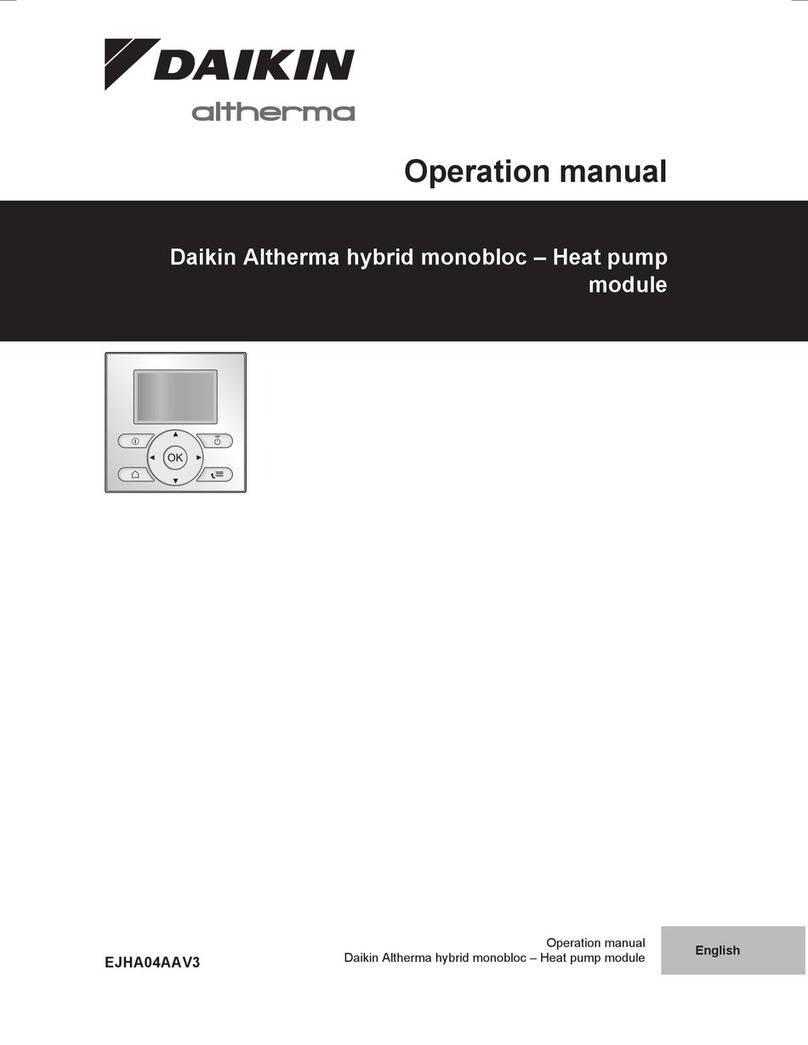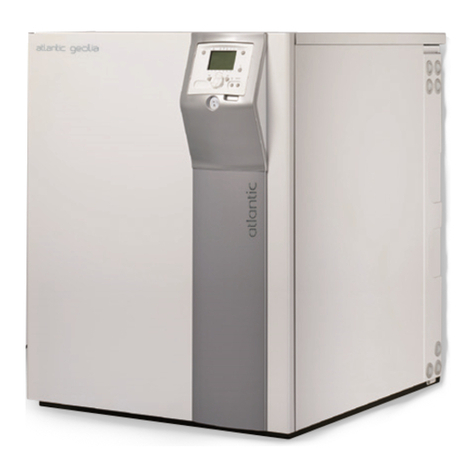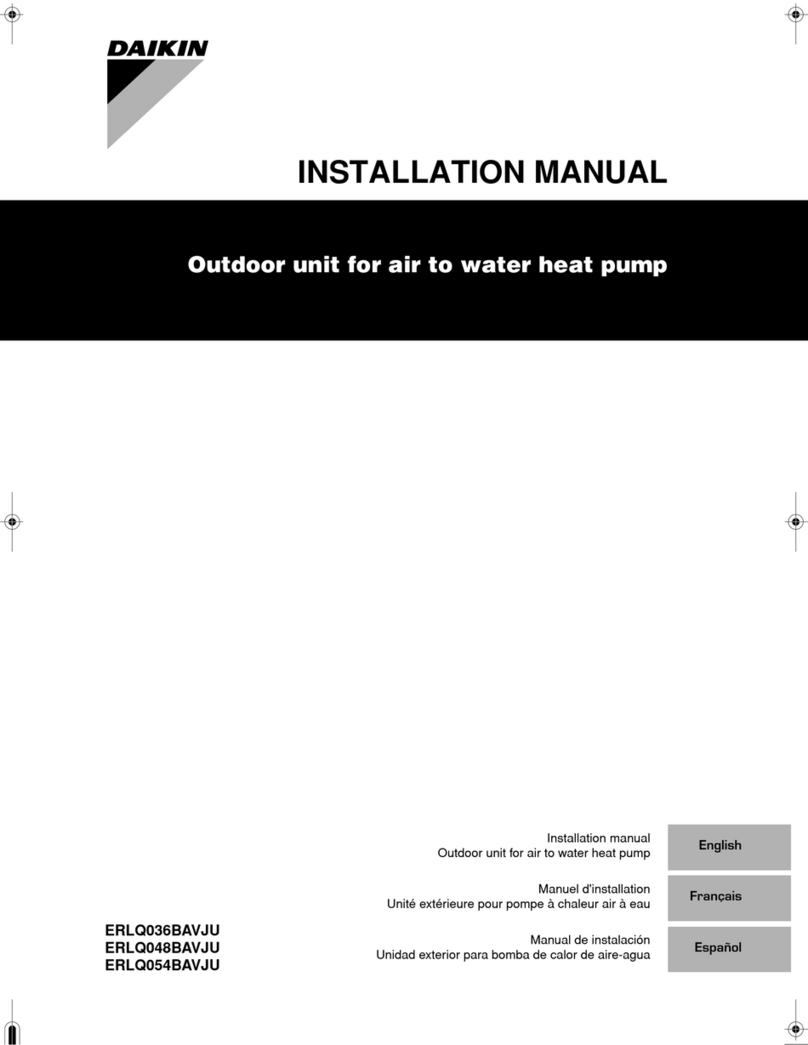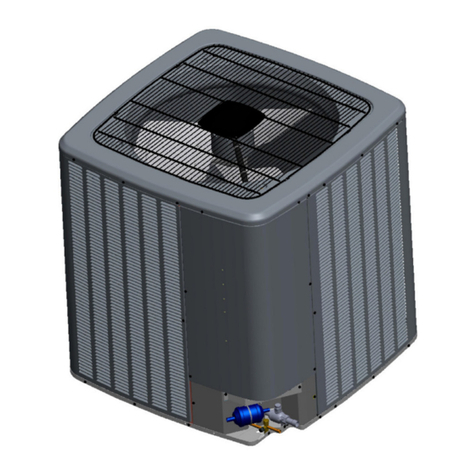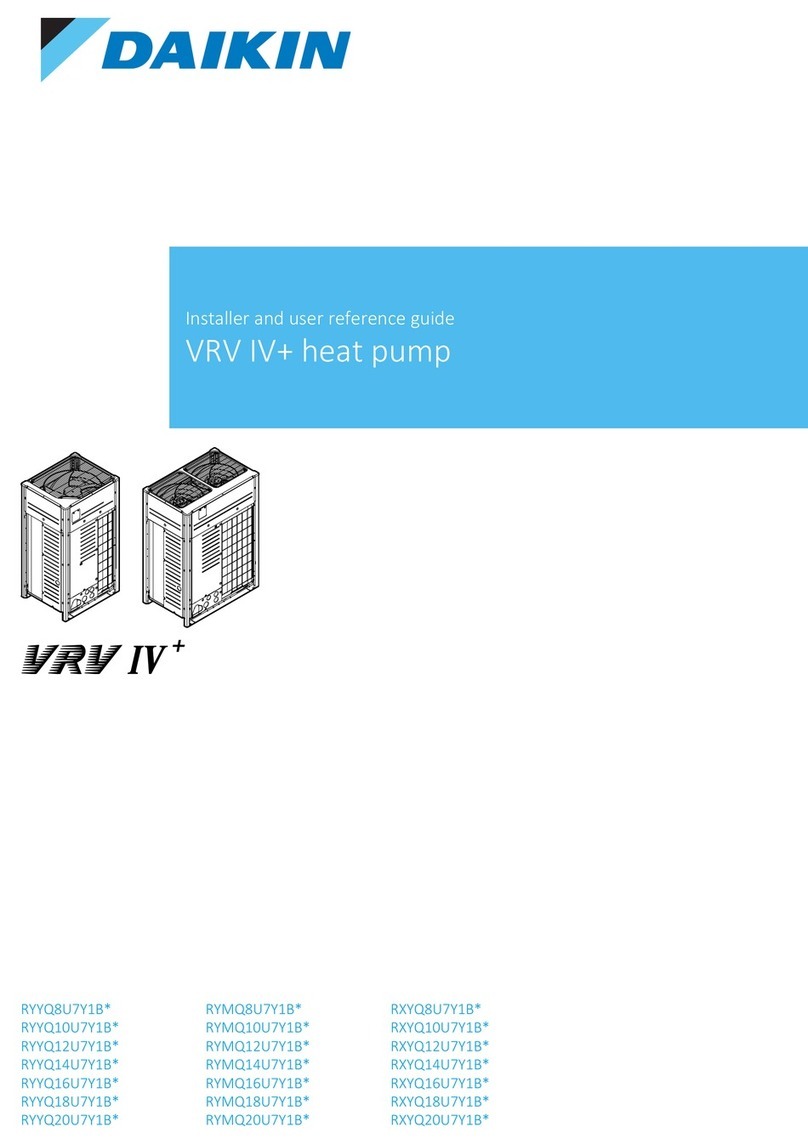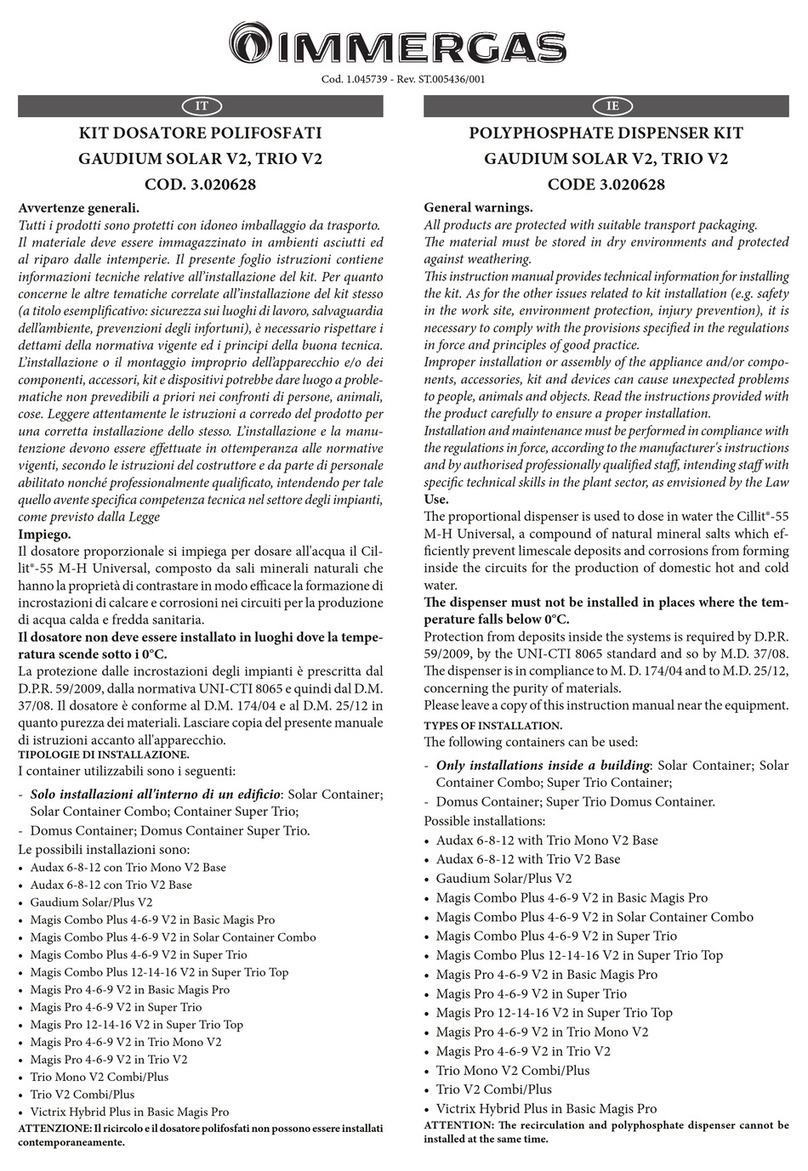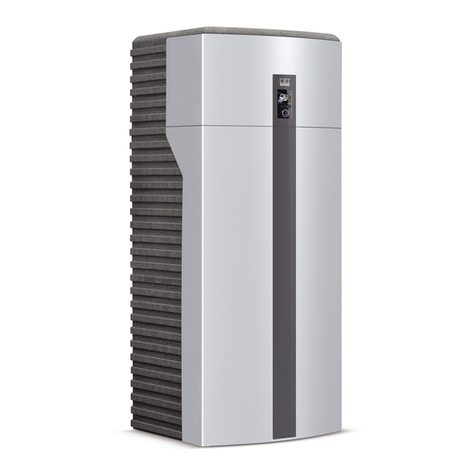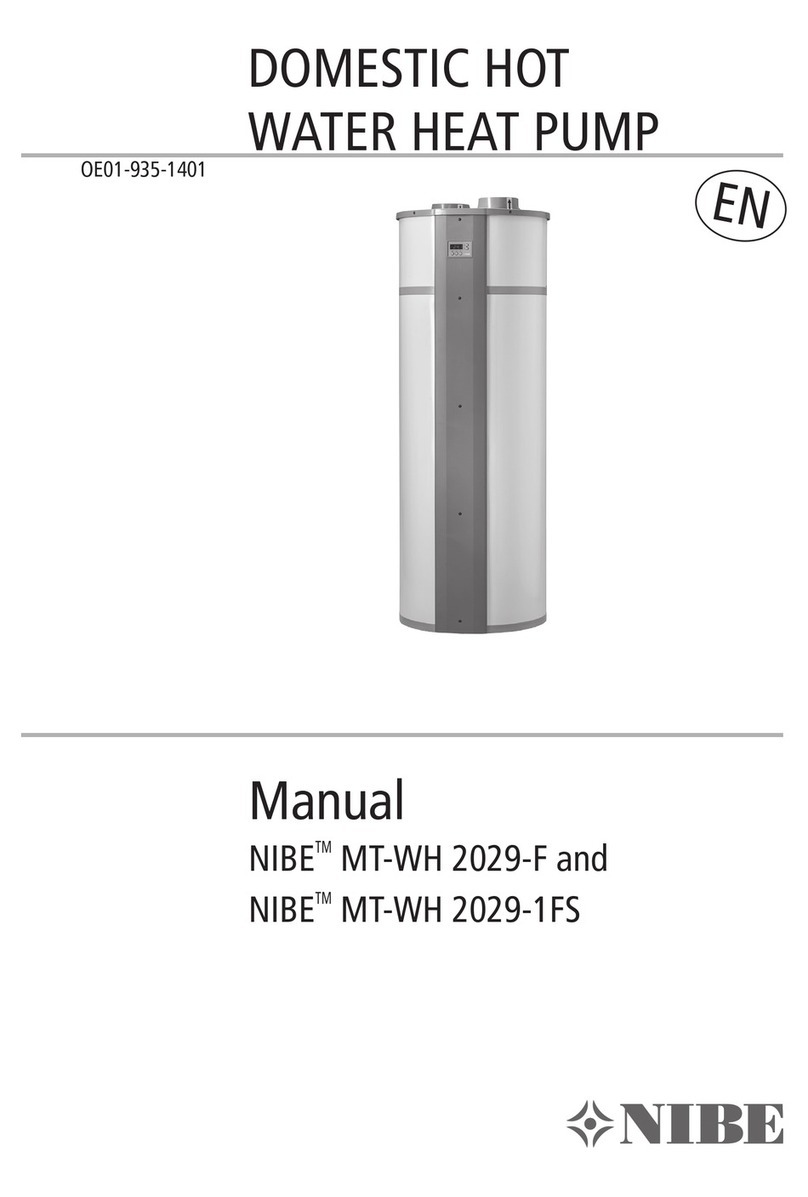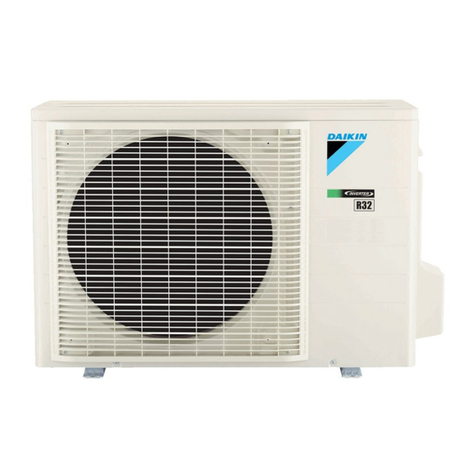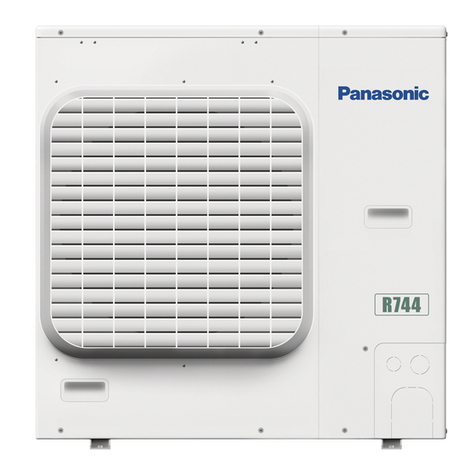Enertech ERC Series Owner's manual

Table of Contents
Model Nomenclature: Console (ERC) Series 3
General Information 4
Unit Physical Data 6
Installation 7
Piping Connections - ERC Size 09-15 9
Piping Connections - ERC Size 18 10
Piping Connections 11
Water-Loop Heat Pump Applications 12
Ground-Loop Heat Pump Applications 13
Ground-Water Heat Pump Applications 14
Water Quality Requirements 16
Electrical - Line Voltage 20
Electrical Data 21
Thermostat 23
ERC Series Wiring Diagram Matrix 25
Controls: CXM2 and DXM2.5 26
Operating Limits and Commissioning Conditions 27
Piping System Cleaning and Flushing 28
Unit and System Checkout Procedure 29
Unit Start-Up Procedure 30
Unit Operating Conditions 31
Start-Up Log Sheet 33
Preventive Maintenance 34
Functional Troubleshooting 35
Performance Troubleshooting 37
Functional Troubleshooting Form 38
Revision History 40
Enertech®
Console
(ERC) Series
Commercial Console
Water-Source
Heat Pumps
Installation, Operation
& Maintenance
97B0035N09
Revised: June 6, 2023

Console (ERC) Series
Rev.: June 6, 2023
Enertech Water-Source Heat Pumps
2
ENERTECH®WATER-SOURCE HEAT PUMPS
This Page Intentionally Left Blank

Console (ERC) Series
Rev.: June 6, 2023
3
Model Nomenclature: Console (ERC) Series
E R CAB
0 9 CG S S C S R S
4 5 6 151 2
ERC = Console
MODEL TYPE
A = Copper Water Coil w/e-Coated Air Coil
C = Copper Water Coil
J = Cupro-nickel Water Coil w/e-Coated Air Coil
N = Cupro-nickel Water Coil
V = Copper Water Coil w/e-Coated Air Coil & Extended Range Insulation
E = Copper Water Coil w/Extended Range Insulation
M = Cupro-nickel Water Coil w/e-Coated Air Coil & Extended Range Insulation
F = Cupro-nickel Water Coil w/Extended Range Insulation
HEAT EXCHANGER OPTIONS
09, 12, 15, 18
UNIT SIZE
B = Current Revision
REVISION LEVEL
G = 208-230/60/1
A = 115/60/1
E = 265/60/1
VOLTAGE
C = ACO Unit Mounted Tstat w/CXM2
D = ACO Unit Mounted Tstat w/DXM2.5
R = Remote Mounted Tstat w/CXM2
S = Remote Mounted Tstat w/DXM2.5
N = Remote Mounted w/CXM2 & MPC
P = Remote Mounted w/DXM2.5 & MPC
CONTROLS
POWER TERMINATION & OPTIONS
FIELD
CONNECTED
(HARD WIRE)
OPTION
20 Amp
PLUG &
CORD
DISCONNECT
SWITCH BREAKER RECEPTACLE
A
B
D
F
K
X
–
–
–
–
–
X
–
–
X
–
–
–
X
X
–
–
X
–
–
–
–
–
–
X
S = Standard
STANDARD
R = Right Piping
L = Left Piping
V = Left Piping w/SS Drain Pan
W = Right Piping w/SS Drain Pan
PIPING CONNECTIONS
S = 5” Subbase
H = 5” Subbase w/Motorized Damper
N = None
1 = 5” Subbase for Chassis Only
2 = 5” Subbase w/Motorized Damper for Chassis Only
SUBBASE
With Sound Attenuation Package
M = Bottom Return
D = Bottom Return w/Locking Control Door
B = Front Return
E = Front Return w/Locking Control Door
C = No Cabinet BR Chassis Only
J = No Cabinet FR Chassis Only
A = Bottom Return w/Extended Cabinet
K = Bottom Return w/Locking Control Door
w/Extended Cabinet
P = Front Return w/Extended Cabinet
Q = Front Return w/Locking Control Door
w/Extended Cabinet
CABINET CONSTRUCTION
Without Sound Attenuation Package
S = Bottom Return
L = Bottom Return w/Locking Control Door
F = Front Return
G = Front Return w/Locking Control Door
N = No Cabinet BR Chassis Only
H = No Cabinet FR Chassis Only
R = Bottom Return w/Extended Cabinet
T = Bottom Return w/Locking Control Door
w/Extended Cabinet
U = Front Return w/Extended Cabinet
V = Front Return w/Locking Control Door
w/Extended Cabinet
WATER CIRCUIT OPTIONS
None
Motorized Water Valve
Autoflow (2.25 Gpm/Ton)
Autoflow (3.0 Gpm/Ton)
Motorized Water Valve & Afr (2.25)
Motorized Water Valve & Afr (3.0)
Secondary Circulation Pump
SWEAT
S
A
B
C
D
E
U
FPT
F
G
H
J
K
L
V
MPT
M
N
P
Q
R
T
W
31413121110987

Console (ERC) Series
Rev.: June 6, 2023
Enertech Water-Source Heat Pumps
4
ENERTECH®WATER-SOURCE HEAT PUMPS
CAUTION: Indicates a potentially hazardous situation or
an unsafe practice, which if not avoided could result in
minor or moderate injury or product or property damage.
NOTICE: Notication of installation, operation, or
maintenance information, which is important, but which is
not hazard-related.
WARNING! To avoid the release of refrigerant into the
atmosphere, the refrigerant circuit of this unit must be
serviced only by technicians who meet local, state, and
federal prociency requirements.
WARNING! All refrigerant discharged from this unit must
be recovered WITHOUT EXCEPTION. Technicians must
follow industry accepted guidelines and all local, state, and
federal statutes for the recovery and disposal of refrigerants.
If a compressor is removed from this unit, refrigerant circuit
oil will remain in the compressor. To avoid leakage of
compressor oil, refrigerant lines of the compressor must be
sealed after it is removed.
CAUTION! To avoid equipment damage, DO NOT use
these units as a source of heating or cooling during the
construction process. The mechanical components and lters
can quickly become clogged with construction dirt and debris,
which may cause system damage and void product warranty.
⚠
WARNING!
⚠
⚠
WARNING!
⚠
⚠
WARNING!
⚠
⚠
CAUTION!
⚠
WARNING! The EarthPure®Application and Service Manual
should be read and understood before attempting to service
refrigerant circuits with HFC-410A.
⚠
WARNING!
⚠
⚠
WARNING!
⚠
WARNING! The installation of water-source heat pumps and
all associated components, parts, and accessories which
make up the installation shall be in accordance with the
regulations of ALL authorities having jurisdiction and MUST
conform to all applicable codes. It is the responsibility of
the installing contractor to determine and comply with ALL
applicable codes and regulations.
WARNING! This appliance is not intended for use by persons
(including children) with reduced physical, sensory, or mental
capabilities, or lack of experience and knowledge, unless
they have been given supervision or instruction concerning
use of the appliance by a person responsible for their safety.
General Information
Safety
Warnings, cautions, and notices appear throughout this
manual. Read these items carefully before attempting any
installation, service, or troubleshooting of the equipment.
DANGER: Indicates an immediate hazardous situation,
which if not avoided will result in death or serious injury.
DANGER labels on unit access panels must be observed.
WARNING: Indicates a potentially hazardous situation,
which if not avoided could result in death or serious injury.

Console (ERC) Series
Rev.: June 6, 2023
5
CAUTION! DO NOT store or install units in corrosive
environments or in locations subject to temperature or
humidity extremes (e.g., attics, garages, rooftops, etc.).
Corrosive conditions and high temperature or humidity can
signicantly reduce performance, reliability, and service life.
Always move and store units in an upright position. Tilting
units on their sides will cause equipment damage.
⚠
CAUTION!
⚠
⚠
CAUTION!
⚠
CAUTION! CUT HAZARD - Failure to follow this caution may
result in personal injury. Sheet metal parts may have sharp
edges or burrs. Use care and wear appropriate protective
clothing, safety glasses and gloves when handling parts and
servicing heat pumps.
General Information, Cont’d.
Inspection - Upon receipt of the equipment, carefully
check the shipment against the bill of lading. Make sure
all units have been received. Inspect the packaging of
each unit, and inspect each unit for damage. Insure that
the carrier makes proper notation of any shortages or
damage on all copies of the freight bill and completes a
common carrier inspection report. Concealed damage
not discovered during unloading must be reported to the
carrier within 15 days of receipt of shipment. If not led
within 15 days, the freight company can deny the claim
without recourse. Note: It is the responsibility of the
purchaser to le all necessary claims with the carrier.
Notify your equipment supplier of all damage within
fteen (15) days of shipment.
Storage - Equipment should be stored in its original
packaging in a clean, dry area. Store units in an upright
position at all times. Stack units a maximum of 3 units high.
Unit Protection - Cover units on the job site with
either the original packaging or an equivalent protective
covering. Cap the open ends of pipes stored on the
job site. In areas where painting, plastering, and/or
spraying has not been completed, all due precautions
must be taken to avoid physical damage to the units and
contamination by foreign material. Physical damage and
contamination may prevent proper start-up and may
result in costly equipment clean-up.
Examine all pipes, ttings, and valves before installing
any of the system components. Remove any dirt or debris
found in or on these components.
Pre-Installation - Installation, Operation, and
Maintenance instructions are provided with each
unit. Horizontal equipment is designed for installation
above false ceiling or in a ceiling plenum. Other unit
congurations are typically installed in a mechanical room.
The installation site chosen should include adequate
service clearance around the unit. Before unit start-up,
read all manuals and become familiar with the unit and its
operation. Thoroughly check the system before operation.
Make sure wall behind the unit is at and smooth.
Prepare units for installation as follows:
1. Compare the electrical data on the unit nameplate
with ordering and shipping information to verify that
the correct unit has been shipped.
2. Keep the cabinet covered with the original packaging
until installation is complete and all plastering,
painting, etc. is nished.
3. Verify refrigerant tubing is free of kinks or dents and
that it does not touch other unit components.
4. Inspect all electrical connections. Connections must
be clean and tight at the terminals.

Console (ERC) Series
Rev.: June 6, 2023
Enertech Water-Source Heat Pumps
6
ENERTECH®WATER-SOURCE HEAT PUMPS
Optional Factory Installed Auto Flow Regulator GPM [LPS]
Model 2.25 GPM/Ton 3 GPM/Ton
92.0 [.126] 2.5 [.158]
12 2.5
[.158] 3.0 [.189]
15 3.0
[.189] 3.5 [.221]
18 3.5
[.221] 4.0 [.252]
Model 09 12 15 18
Compressor (1 Each) Rotary
Factory Charge HFC-410A (oz) [kg] 28 [0.794] 29 [0.822] 33 [0.907] 39 [1.105]
Blower Wheel
Blower Wheel Size (dia x w) -
(in) [mm] - Qty 2 5.25 x 6.25 [133 x 159]
Water Connection Size
O.D. Sweat (in) [mm] 1/2 [12.7] 3/4 [19.1]
Optional FPT Fittings (in) 1/2 3/4
Optional MPT Fittings (in) 1/2 3/4
Coax Volume
Volume US Gal
[Liters]
.09
[.34]
.09
[.34]
.23
[.87]
.26
[.98]
Condensate Connection Size
I.D. Vinyl Hose (In) [mm] 5/8 [15.9]
Air Coil Size
Dimensions (h x w) - (in) [mm] 8 x 26
[203 x 660]
10 x 26
[254 x 660]
10 x 32
[254 x 812]
Filter Size
Bottom Return (in) [mm] 1 - 10 x 30 x 1 [254 x 762 x 25] 1 - 10 x 36 x 1 [254 x 914 x 25]
Front Return (In) [mm] 1 - 7 x 29.5 x 1/8 [178 x 749 x 3.2] 1 - 7 x 35.5 x 1/8 [178 x 902 x 3.2]
Unit Size
Bottom Return (Std. 5” Base)
(W x H x D) - (In) [mm] 48 x 26 x 12 [1219 x 660 x 305] 54 x 26 x 12 [1372 x 660 x 305]
Front Return (No Subbase)
(W x H x D) - (In) [mm] 48 x 21 x 12 [1219 x 533 x 305] 54 x 21 x 12 [1372 x 533 x 305]
Unit Weight
Weight - Operating, (lbs) [kg] 175 [79] 180 [82] 190 [86.2] 220 [99.8]
Weight - Packaged, (lbs) [kg] 185 [83.9] 190 [86] 200 [90.8] 232 [105.2]
All units have rubber grommet compressor mountings and TXV expansion devices.
Unit Maximum Water Working Pressure
Options Max Pressure PSIG [kPa]
Base Unit 500 [3,445]
Internal Secondary Pump (ISP)
145 [999]
Internal Motorized Water Valve (MWV)
300 [2,068]
Internal Auto Flow Valve
500 [3,445]
Use the lowest maximum pressure rating when multiple options are combined.
Optional hoses have pressure rating of 400 PSIG (2758 (kPa)
Unit Physical Data

Console (ERC) Series
Rev.: June 6, 2023
7
CAUTION! Poor or inadequate installation may result in
noisy unit operation or unattractive installation.
⚠
CAUTION!
⚠
Installation
The installation of Console Water-Source Heat Pumps
and all associated components, parts and accessories
that make up the installation shall be in accordance with
the regulations of ALL Authorities having jurisdiction
and MUST conform to all applicable Codes. It is the
responsibility of the Installing Contractor to determine and
comply with ALL applicable Codes and Regulations.
Note: An Installation Checklist is provided in this
manual. Complete this checklist after all installation
procedures are completed. A periodic maintenance
checklist provided in the Maintenance section outlines
recommended maintenance schedules. A Start-Up
Inspection Log is also included at the end of this
manual to encourage thorough unit checkout at initial
start-up. These checklists are not a substitute for the
detailed information found in the Installation section of
this manual
.
1. Console units are typically installed along an outside
wall of the room. Provide adequate space in front
of the unit for service and maintenance. Locate
the Console Unit so that it provides adequate air
circulation throughout the room.
2. Unpack the Console Unit from the shipping carton.
Remove the front cabinet by lifting up and away
from the backplate. Protect the cabinet from damage
during installation by returning it to its original
packaging until required.
3. Using a carpenter’s square and a level, ensure the
unit is level. Shim the unit if necessary to assure
proper installation.
4. Select the proper fasteners to connect the backplate
securely to the wall.
5. Fasten the backplate onto the wall through the screw
holes located in the back ange. Secure the subbase
in place for bottom return units only.
6. Remove subbase shipping support bracket and discard.
7. Make all necessary electrical connections as described
in the Electrical Wiring section of this manual. Consult
the wiring diagram to ensure proper hook-up.
8. Connect the nal piping as described in the Supply
and Return Piping and Condensate Piping section
of the manual. Install shut-off valves, piping and/or
hoses and other accessories as specied.
9. Before making the nal water connections, ush the
system as described in the Start Up section of this
manual. After ushing the system, connect piping and
hoses to the proper supply, return and condensate
connections of the unit.
Note: When necessary, use adapters to connect
hoses.
10. Install any other system components as required
following manufacturer’s instructions.
Note: When using replacement 3 inch subbase,
unit will not be able to use low fan speed setting.
When using a 5 inch subbase, low fan speed
setting is allowed.
11. After Start-up, reinstall the front cabinet by carefully
lowering the front cabinet over the chassis onto the
backplate.
Supply and Return Hoses - Optional pressure-rated
hose assemblies 400 psi [2758 kPa] are available for use
with Console Units. Use the following guidelines when
installing supply and return hose assemblies.
1. Install supply and return hoses tted with swivel-joint
ttings at one end to prevent the hose from twisting.
2. Use adapters to secure the hose assembly to the unit
and the riser.
3. Do not allow the hose to twist during installation.
Twisting may damage the hose wall or the interior
rubber compound.
4. Use pipe joint compound sparingly on the pipe
threads of the tting adapters.
5. Prevent sealant from reaching the ared surfaces of
the joint.
6. Do not use pipe joint compound when Teon®thread
tape is pre-applied to hose assemblies or when
ared-end connections are used.
7. Maximum torque which may be applied to brass
ttings is 30 ft-lbs [41 N-m]. When a torque wrench
is not used, tighten brass ttings nger-tight plus one
quarter turn.
8. Tighten steel ttings as necessary.
9. Shut-off/balancing valves, ow indicators, and drain
tees in the supply runout and return at each oor to
aid in loop balancing and servicing.

Console (ERC) Series
Rev.: June 6, 2023
Enertech Water-Source Heat Pumps
8
ENERTECH®WATER-SOURCE HEAT PUMPS
⚠
CAUTION!
⚠
CAUTION! Loop Fluids should be of good quality with no
more than 0.50 ppm of chlorides w/copper heat exchangers
(125 ppm w/ Cupro-nickel) to prevent corrosion and should
also be ltered to a maximum 800 micron [0.8mm particle
size to prevent erosion of the heat exchangers.
Installation, Cont’d.
Condensate Piping - Unit is supplied with condensate
drain hose, 5/8 inch [16 mm] I.D. exible plastic
nonpressure-rated, protruding from piping side of unit.
Connect this hose to building drain. Avoid making kinks
in hose to ensure an unobstructed ow of condensate
from the unit to the drain. DO NOT twist, pull hose out,
or push excess hose into unit. If hose will not connect to
your building drain several options include, relocate end
of building drain, add to or cut hose, use hard plastic or
copper elbow ttings for tight radii (put inside hose). Keep
hose positioned within or over subbase area so hose does
not interfere with front cabinet. Cabinet should not push or
reroute hose. Clamp all joints watertight. Check for leaks.
Internally the drain hose is clamped to drain pan and
pitched correctly. Horizontal runs of condensate hose
should be pitched downward 1/4 inch minimum for
every foot [10 mm per 46 cm] of hose. Avoid low points
because dirt collects in these areas and may cause
blockage. If blocked the condensate level in drain pan
increases. When the level gets too high, the Console unit
has sensor switch that will shut unit off. Overow may
still occur.
If the building drain connection is parallel with oor, the
height can be up to 1-1/2 inches [38 mm] above the
subbase for proper pitch and correct drainage. Up to 5
inches [127 mm] above the subbase is allowable, but
drainage will be slower. When the drain connection
is 2-1/2 to 5 inches [64 to 127 mm] above, the hose
inside the unit will act as a trap. Heights of more than 5
inches [127 mm] above the subbase are NOT allowable
(condensate overow may occur). If the unit has a
disconnect option, drain locations are limited. See unit
conguration pages for details.
Field installation of a trap or vent is not required unless
specied by local codes. Console units are designed in
a blow-through conguration. The condensate drain
pan is located on the outlet side of the blower so that
the pressure in the drain pan is higher than atmospheric
pressures.
When drain connection is completed check for proper
drainage and leaks. Correct if necessary.
If trap is used, check and clean often. See Preventive
Maintenance Instructions.

Console (ERC) Series
Rev.: June 6, 2023
9
CAUTION! Corrosive system water requires corrosion
resistant ttings and hoses, and may require water treatment.
CAUTION! Piping must comply with all applicable codes.
⚠
CAUTION!
⚠⚠
CAUTION!
⚠
Piping Connections – ERC Size 09-15
Left Hand Configuration
Water In
Water Out
Notes:*Dimension reduced by fitting if selected
2.72
(96)
Right Hand Configuration
Water In
Water Out
Blower Deck
Blower Access Panel
Compressor
Access
Panel
Control Box
1.84
(47)
0.75
(19)
20.50
(521)
40.98
(1040)
Condensate
Condensate
5/8" (15.9) ID
Vinyl Hose
Optional
Motorized
Water Valve
Optional
Autoflow
Valve
Water Connections
5/8" (15.9)
OD Copper,
1/2" FPT or
1/2" MPT
Optional
Disconnect Box
(mounted to cabinet
not chassis)
Optional
Motorized
Water Valve
Optional
Autoflow
Valve
Water Connections
5/8" (15.9AA)
OD Copper,
1/2" FPT or
1/2" MPT
Optional Fused
Disconnect Box
(mounted to cabinet
not chassis)
Also Available in Non-Fused
Optional Disconnect
Only Box (All Configurations)
Optional Flow
Regulator
Optional
Motorized
Water Valve
1.75 (44)
Out
In
Water Connections
5/8” (15.9) OD
Copper, 1/2” FPT, or
1/2” MPT
2.25
(57)
In
Out
*11.25 (286)
2.00
(51)
1.50 (38)
8.00 Min
(203)
2.25
(57)
5/8" (15.9) ID
Vinyl Hose
8.00 Min
(203)
Water Connections
5/8” (15.9) OD
Copper, 1/2” FPT,
or 1/2” MPT
*11.25 (286)
1.62 (41)
2.00
(51)
2.25
(57)
CAUTION!Corrosive system water requires corrosion
treatment.
CAUTION!
CAUTION! Piping must comply with all applicable codes.
CAUTION!
Left Hand Configuration
Water In
Water Out
Notes:*Dimension reduced by fitting if selected
2.72
(96)
Right Hand Configuration
Water In
Water Out
Blower Deck
Blower Access Panel
Compressor
Access
Panel
Control Box
1.84
(47)
0.75
(19)
20.50
(521)
40.98
(1040)
Condensate
Condensate
5/8" (15.9) ID
Vinyl Hose
Optional
Motorized
Water Valve
Optional
Autoflow
Valve
Water Connections
5/8" (15.9)
OD Copper,
1/2" FPT or
1/2" MPT
Optional
Disconnect Box
(mounted to cabinet
not chassis)
Optional
Motorized
Water Valve
Optional
Autoflow
Valve
Water Connections
5/8" (15.9AA)
OD Copper,
1/2" FPT or
1/2" MPT
Optional Fused
Disconnect Box
(mounted to cabinet
not chassis)
Also Available in Non-Fused
Optional Disconnect
Only Box (All Configurations)
Optional Flow
Regulator
Optional
Motorized
Water Valve
1.75 (44)
Out
In
Water Connections
5/8” (15.9) OD
Copper, 1/2” FPT, or
1/2” MPT
2.25
(57)
In
Out
*11.25 (286)
2.00
(51)
1.50 (38)
8.00 Min
(203)
2.25
(57)
5/8" (15.9) ID
Vinyl Hose
8.00 Min
(203)
Water Connections
5/8” (15.9) OD
Copper, 1/2” FPT,
or 1/2” MPT
*11.25 (286)
1.62 (41)
2.00
(51)
2.25
(57)
CAUTION!Corrosive system water requires corrosion
treatment.
CAUTION!
CAUTION! Piping must comply with all applicable codes.
CAUTION!

Console (ERC) Series
Rev.: June 6, 2023
Enertech Water-Source Heat Pumps
10
ENERTECH®WATER-SOURCE HEAT PUMPS
CAUTION! Corrosive system water requires corrosion
resistant ttings and hoses, and may require water treatment.
CAUTION! Piping must comply with all applicable codes.
⚠
CAUTION!
⚠⚠
CAUTION!
⚠
Piping Connections, Cont’d. – ERC Size 18
Left Hand Configuration
Water In
Water Out
Notes:*Dimension reduced by fitting if selected
2.72
(96)
Right Hand Configuration
Water In
Water Out
Blower Deck
Blower Access Panel
Compressor
Access
Panel
Control Box
1.84
(47)
0.75
(19)
20.50
(521)
40.98
(1040)
Condensate
Condensate
5/8" (15.9) ID
Vinyl Hose
Optional
Motorized
Water Valve
Optional
Autoflow
Valve
Water Connections
5/8" (15.9)
OD Copper,
1/2" FPT or
1/2" MPT
Optional
Disconnect Box
(mounted to cabinet
not chassis)
Optional
Motorized
Water Valve
Optional
Autoflow
Valve
Water Connections
5/8" (15.9AA)
OD Copper,
1/2" FPT or
1/2" MPT
Optional Fused
Disconnect Box
(mounted to cabinet
not chassis)
Also Available in Non-Fused
Optional Disconnect
Only Box (All Configurations)
Optional Flow
Regulator
Optional
Motorized
Water Valve
1.75 (44)
Out
In
Water Connections
5/8” (15.9) OD
Copper, 1/2” FPT, or
1/2” MPT
2.25
(57)
In
Out
*11.25 (286)
2.00
(51)
1.50 (38)
8.00 Min
(203)
2.25
(57)
5/8" (15.9) ID
Vinyl Hose
8.00 Min
(203)
Water Connections
5/8” (15.9) OD
Copper, 1/2” FPT,
or 1/2” MPT
*11.25 (286)
1.62 (41)
2.00
(51)
2.25
(57)
CAUTION!Corrosive system water requires corrosion
treatment.
CAUTION!
CAUTION! Piping must comply with all applicable codes.
CAUTION!
NOTES: *Dimension reduced by tting if selected

Console (ERC) Series
Rev.: June 6, 2023
11
CAUTION! Do not bend or kink supply lines or hoses.
⚠
CAUTION!
⚠
WARNING! Polyolester Oil, commonly known as POE oil, is
a synthetic oil used in many refrigeration systems including
those with HFC-410A refrigerant. POE oil, if it ever comes
in contact with PVC or CPVC piping, may cause failure of
the PVC/CPVC. PVC/CPVC piping should never be used
as supply or return water piping with water source heat
pump products containing HFC-410A as system failures and
property damage may result.
⚠
WARNING!
Piping Connections, Cont’d.
Installation of Supply and Return Piping - Follow these
piping guidelines.
1. Install a drain valve at the base of each supply and
return riser to facilitate system ushing.
2. Install shut-off / balancing valves and unions at each
unit to permit unit removal for servicing.
3. Place strainers at the inlet of each system circulating
pump.
4. Select the proper hose length to allow slack between
connection points. Hoses may vary in length by +2%
to -4% under pressure.
5. Refer to Table 1. Do not exceed the minimum bend
radius for the hose selected. Exceeding the minimum
bend radius may cause the hose to collapse, which
reduces water ow rate. Install an angle adapter to
avoid sharp bends in the hose when the radius falls
below the required minimum.
Insulation is not required on loop water piping except
where the piping runs through unheated areas, outside
the building or when the loop water temperature is below
the minimum expected dew point of the pipe ambient
conditions. Insulation is required if loop water temperature
drops below the dew point (insulation is required for
ground loop applications in most climates).
Pipe joint compound is not necessary when Teon®
thread tape is pre-applied to hose assemblies or when
ared-end connections are used. If pipe joint compound
is preferred, use compound only in small amounts on
the external pipe threads of the tting adapters. Prevent
sealant from reaching the ared surfaces of the joint.
Note: When antifreeze is used in the loop, insure
that it is compatible with the Teon tape or pipe joint
compound that is applied.
Maximum allowable torque for brass ttings is 30 ft-lbs
[41 N-m]. If a torque wrench is not available, tighten
nger-tight plus one quarter turn. Tighten steel ttings
as necessary.
Optional pressure-rated hose assemblies designed
specically for use with console water source heat pump
units are available. Similar hoses can be obtained from
alternate suppliers. Supply and return hoses are tted
with swivel-joint ttings at one end to prevent kinking
during installation.
Refer to Figure 2 for an illustration of a typical supply/
return hose kit. Adapters secure hose assemblies to the
unit and risers. Install hose assemblies properly and check
regularly to avoid system failure and reduced service life.
Table 1: Metal Hose Minimum Bend Radii
Hose Diameter Minimum Bend Radii
1/2" [12.7mm] 2-1/2" [6.4cm]
3/4" [19.1mm] 4" [10.2cm]
1" [25.4mm] 5-1/2" [14cm]
NOTICE! Do not allow hoses to rest against structural
building components. Compressor vibration may be
transmitted through the hoses to the structure, causing
unnecessary noise complaints.
Figure 2: Supply/Return Hose Kit
Rib Crimped
Length
(2 ft [0.6m] Length Standard)
Swivel
Brass
Fitting
Brass
Fitting
MPT
Reborde Acanalado
Longitud
(Long. Estándar de 2 pies)
Accesorio
Giratorio
de Bronce
Accesorio
de Bronce
MPT
MPT
MPT
Rib Crimped
Length
(0.6m Length Standard)
Swivel
Brass
Fitting
Brass
Fitting
MPT
MPT

Console (ERC) Series
Rev.: June 6, 2023
Enertech Water-Source Heat Pumps
12
ENERTECH®WATER-SOURCE HEAT PUMPS
Water-Loop Heat Pump Applications
Commercial Water Loop Applications -
Commercial
systems typically include a number of units connected to
a common piping system. Any unit plumbing maintenance
work can introduce air into the piping system; therefore air
elimination equipment is a major portion of the mechanical
room plumbing. In piping systems expected to utilize water
temperatures below 50°F [10°C], 1/2” (13 mm) closed cell
insulation is required on all piping surfaces to eliminate
condensation (extended range units required). Metal to
plastic threaded joints should never be used due to their
tendency to leak over time.
Teon®tape thread sealant is recommended to minimize
internal fouling of the heat exchanger. Do not over tighten
connections and route piping so as not to interfere with
service or maintenance access. Hose kits are available from
the manufacturer in different congurations for connection
between the unit and the piping system. Depending upon
selection, hose kits may include shut off valves, P/T plugs
for performance measurement, high pressure stainless steel
braided hose, “Y” type strainer with blow down valve, and/or
“J” type swivel connection. Balancing valves and an external
low pressure drop solenoid valve for use in variable speed
pumping systems may also be included in the hose kit.
The piping system should be ushed to remove dirt, piping
chips, and other foreign material prior to operation (see
“Piping System Cleaning and Flushing Procedures” in this
manual). The ow rate is usually set between 2.25 and 3.5
gpm per ton [2.9 and 4.5 l/m per kW] of cooling capacity.
the manufacturer recommends 3 gpm per ton [3.9 l/m per
kW] for most applications of water loop heat pumps. To
insure proper maintenance and servicing, P/T ports are
imperative for temperature and ow verication, as well as
performance checks.
Water loop heat pump (cooling tower/boiler) systems
typically utilize a common loop, maintained between 60 -
90°F [16 - 32°C]. The use of a closed circuit evaporative
cooling tower with a secondary heat exchanger between
the tower and the water loop is recommended. If an open
type cooling tower is used continuously, chemical treatment
and ltering will be necessary.
Table 2: Antifreeze Percentages by Volume
Low Water Temperature Cutout Setting - CXM2 Control
When antifreeze is selected, the LT1 jumper (JW3) should
be clipped to select the low temperature (antifreeze 10.0°F
[-12.2°C]) setpoint and avoid nuisance faults (see “Low
Water Temperature Cutout Selection” in this manual).
NOTE: Low water temperature operation requires
extended range equipment.
Type Minimum Temperature for Freeze Protection
10ºF [-12.2ºC] 15ºF [-9.4ºC] 20ºF [6.7ºC] 25ºF [-3.9ºC]
Methanol - 100% USP food grade 25% 21% 16% 10%
Propylene Glycol 38% 30% 22% 15%

Console (ERC) Series
Rev.: June 6, 2023
13
CAUTION! The following instructions represent industry
accepted installation practices for closed loop earth coupled
heat pump systems. Instructions are provided to assist the
contractor in installing trouble free ground loops. These
instructions are recommendations only. State/provincial
and local codes MUST be followed and installation MUST
conform to ALL applicable codes. It is the responsibility of
the installing contractor to determine and comply with ALL
applicable codes and regulations.
CAUTION! Ground loop applications require extended range
equipment and optional refrigerant/water circuit insulation.
⚠
CAUTION!
⚠
⚠
CAUTION!
⚠
Ground-Loop Heat Pump Applications
Pre-Installation -
Prior to installation, locate and mark
all existing underground utilities, piping, etc. Install loops
for new construction before sidewalks, patios, driveways,
and other construction has begun. During construction,
accurately mark all ground loop piping on the plot plan as an
aid in avoiding potential future damage to the installation.
Piping Installation - All earth loop piping materials
should be limited to polyethylene fusion only for in-ground
sections of the loop. Galvanized or steel ttings should not
be used at any time due to their tendency to corrode. All
plastic to metal threaded ttings should be avoided due
to their potential to leak in earth coupled applications. A
anged tting should be substituted. P/T plugs should be
used so that ow can be measured using the pressure
drop of the unit heat exchanger.
Earth loop temperatures can range between 25 and
110°F [-4 to 43°C]. Flow rates between 2.25 and 3 gpm
per ton [2.41 to 3.23 l/m per kW] of cooling capacity is
recommended in these applications.
Test individual horizontal loop circuits before backlling.
Test vertical U-bends and pond loop assemblies prior to
installation. Pressures of at least 100 psi [689 kPa] should
be used when testing. Do not exceed the pipe pressure
rating. Test entire system when all loops are assembled.
Flushing the Earth Loop - Upon completion of system
installation and testing, ush the system to remove all
foreign objects and purge to remove all air.
Antifreeze - If any liquid uid or piping is exposed to
unconditioned ambient below 42°F (5.5 C), antifreeze
must be added. If the liquid uid entering the heat pump
is 50°F (10°C) or below, calculate the leaving heat pump
temperature (shown in submittal on performance data
selection notes section). Using the lowest temperature
leaving the heat pump, must protect system 15°F (8°C)
lower. IE: if temperature leaving the heat pump is 35°F
subtract 15°F = 20°F protection required, if Methanol
is used the system would require 16% mix by volume.
Antifreeze is available in alcohol and glycols, contact
local sales ofce for the best type for your system and
area. Following must be considered safety, thermal
performance, corrosiveness, local codes, stability,
convenience, and cost.
All alcohols should be premixed and pumped from
a reservoir outside of the building when possible or
introduced under the water level to prevent fumes.
Calculate the total volume of uid in the piping system.
Then use the percentage by volume shown in table 2 for
the amount of antifreeze needed. Antifreeze concentration
should be checked from a well mixed sample using a
hydrometer to measure specic gravity.
Low Water Temperature Cutout Setting - CXM2 Control
When antifreeze is selected, the LT1 jumper (JW3) should
be clipped to select the low temperature (antifreeze 10.0°F
[-12.2°C]) setpoint and avoid nuisance faults (see “Low
Water Temperature Cutout Selection” in this manual).
NOTE: Low water temperature operation requires
extended range equipment.

Console (ERC) Series
Rev.: June 6, 2023
Enertech Water-Source Heat Pumps
14
ENERTECH®WATER-SOURCE HEAT PUMPS
Ground-Water Heat Pump Applications
Open Loop - Ground Water Systems -
Shut off valves
should be included for ease of servicing. Boiler drains or
other valves should be “tee’d” into the lines to allow acid
ushing of the heat exchanger. Shut off valves should be
positioned to allow ow through the coax via the boiler
drains without allowing ow into the piping system.
P/T plugs should be used so that pressure drop and
temperature can be measured. Supply and return water
piping materials should be limited to copper, PE, or similar
material. PVC or CPVC should never be used as they are
incompatible with the POE oils used in HFC-410A products
and piping system failure and property damage may result.
Water quantity should be plentiful and of good quality.
Consult table 3 for water quality guidelines. The unit can
be ordered with either a copper or cupro-nickel water
heat exchanger. Consult Table 3 for recommendations.
Copper is recommended for closed loop systems and open
loop ground water systems that are not high in mineral
content or corrosiveness. In conditions anticipating heavy
scale formation or in brackish water, a cupro-nickel heat
exchanger is recommended. In ground water situations
where scaling could be heavy or where biological growth
such as iron bacteria will be present, an open loop system
is not recommended. Heat exchanger coils may over time
lose heat exchange capabilities due to build up of mineral
deposits. Heat exchangers must only be serviced by a
qualied technician, as acid and special pumping equipment
is required. Desuperheater coils can likewise become scaled
and possibly plugged. In areas with extremely hard water,
the owner should be informed that the heat exchanger
may require occasional acid ushing. In some cases, the
desuperheater option should not be recommended due to
hard water conditions and additional maintenance required.
Water Quality Requirements -
Table 3 should be
consulted for water quality requirements. Scaling potential
should be assessed using the pH/Calcium hardness
method. If the pH <7.5 and the calcium hardness is less
than 100 ppm, scaling potential is low. If this method yields
numbers out of range of those listed, the Ryznar Stability
WARNING! Polyolester Oil, commonly known as POE oil, is
a synthetic oil used in many refrigeration systems including
those with HFC-410A refrigerant. POE oil, if it ever comes
in contact with PVC or CPVC piping, may cause failure of
the PVC/CPVC. PVC/CPVC piping should never be used
as supply or return water piping with water source heat
pump products containing HFC-410A as system failures and
property damage may result.
⚠
WARNING!
⚠
and Langelier Saturation indicies should be calculated.
Use the appropriate scaling surface temperature for the
application, 150°F [66°C] for direct use (well water/open
loop) and DHW (desuperheater); 90°F [32°F] for indirect
use. A monitoring plan should be implemented in these
probable scaling situations. Other water quality issues
such as iron fouling, corrosion prevention and erosion and
clogging should be referenced in Table 3.
Expansion Tank and Pump -
Use a closed, bladder-type
expansion tank to minimize mineral formation due to air
exposure. The expansion tank should be sized to provide at
least one minute continuous run time of the pump using its
draw down capacity rating to prevent pump short cycling.
Discharge water from the unit is not contaminated in any
manner and can be disposed of in various ways, depending
on local building codes (e.g. recharge well, storm sewer,
drain eld, adjacent stream or pond, etc.). Most local codes
forbid the use of sanitary sewer for disposal. Consult your
local building and zoning department to assure compliance
in your area.
Water Control Valve -
Always maintain water pressure
in the heat exchanger by placing the water control valve(s)
on the discharge line to prevent mineral precipitation
during the off-cycle. Pilot operated slow closing valves are
recommended to reduce water hammer. If water hammer
persists, a mini-expansion tank can be mounted on the
piping to help absorb the excess hammer shock. Insure that
the total ‘VA’ draw of the valve can be supplied by the unit
transformer. For instance, a slow closing valve can draw up
to 35VA. This can overload smaller 40 or 50 VA transformers
depending on the other controls in the circuit. A typical pilot
operated solenoid valve draws approximately 15VA.

Console (ERC) Series
Rev.: June 6, 2023
15
Ground-Water Heat Pump Applications, Cont’d.
Flow Regulation -
Flow regulation can be accomplished
by two methods. One method of ow regulation involves
simply adjusting the ball valve or water control valve on the
discharge line. Measure the pressure drop through the unit
heat exchanger, and determine ow rate. Since the pressure
is constantly varying, two pressure gauges may be needed.
Adjust the valve until the desired ow of 1.5 to 2 gpm per
ton [2.0 to 2.6 l/m per kW] is achieved. A second method
of ow control requires a ow control device mounted on
the outlet of the water control valve. The device is typically
a brass tting with an orice of rubber or plastic material
that is designed to allow a specied ow rate. On occasion,
ow control devices may produce velocity noise that can be
reduced by applying some back pressure from the ball valve
located on the discharge line. Slightly closing the valve will
spread the pressure drop over both devices, lessening the
velocity noise.
Note: When EWT is below 50°F [10°C], 2
gpm per ton (2.6 l/m per kW) is required.
Water Coil Low Temperature Limit Setting -
For all open
loop systems the 30°F [-1.1°C] LT1 setting (factory setting-
water) should be used to avoid freeze damage to the unit.
See “Low Water Temperature Cutout Selection” in this
manual for details on the low limit setting.
Notice! Ground-water applications for commercial
buildings with more than 2-3 units should include a
plate frame heat-exchanger to isolate the heat pumps
from the ground-water and conne heat exchanger
cleanings to one location and lessen maintenance.
Direct use of ground-water may increase the
frequency of heat pump maintenance and may
shorten life expectancy.

Console (ERC) Series
Rev.: June 6, 2023
Enertech Water-Source Heat Pumps
16
ENERTECH®WATER-SOURCE HEAT PUMPS
Water Quality Requirements
pH - Chilled Water 0.7F°58< to 9.0 7.0 to 9.0 7.0 to 9.0 7.0 to 9.0
pH - Heated Water 0.8F°58> to 10.0 8.0 to 10.0 8.0 to 10.0 8.0 to 10.0
Alkalinity
(
HCO3
)
ppm - CaCO
3
equiv. 50 to 500 50 to 500 50 to 500 50 to 500
Calcium (Ca)ppm <100 <100 <100 <100
Magnesium (Mg)ppm <100 <100 <100 <100
Total Hardness (CaCO3)ppm - CaCO3 equiv. 30 to 150 150 to 450 150 to 450 150 to 450
Langelier Satura�on Index LSI -0.5 to +0.5 -0.5 to +0.5 -0.5 to +0.5 -0.5 to +0.5
Ryznar Stability 5.6ISRxednI to 8.0 6.5 to 8.0 6.5 to 8.0 6.5 to 8.0
Total Dissolved Solids (TDS) ppm - CaCO
3
equiv. <1000 <1000 <1000 <1500
Sulfate (SO
4
2-
)ppm <200 <200 <200 <200
Nitrate(NO
3
-
)001<001<001<001<mpp
Chlorine (free)(Cl) ppm <0.5 <0.5 <0.5 <0.5
Chloride (water < 80°F) ppm <20 <20 <150 <150
Chloride (water > 120°F) ppm <20 <20 <125 <125
Hydrogen Sulfideα(H
2
S) 5.0<5.0<5.0<5.0<bpp
Carbon Dioxide (CO
2
)ppm 0 <50 10 to 50 10 to 50
Iron Oxide (Fe) ppm <1.0 <1.0 <1.0 <0.2
Manganese (Mn)ppm < 0.4 <0.4 <0.4 <0.4
Ammonia (NH
3
)ppm <0.05 <0.1 <0.1 <0.1
Chloramine (NH
2
CL) ppm 0 0 0 0
Iron 0000Lm/sllecairetcaB
Slime Forming 0000Lm/sllecairetcaB
Sulfate reducing 0000Lm/sllecairetcab
Suspended Solidsβ01<01<01<01<mpp)SST(
Earth Ground Resistanceχ0smhO Consult NEC & local electrical codes for grounding requirements
Electrolysis Voltageδ003<Vm Measure voltage internal water loop to HP ground
Leakage Currentδ51<Am Measure current in water loop pipe
Building Primary Electrical Ground to unit, must meet local diameter and penetra�on length requirements
WATER QUALITY REQUIREMENTS
For Closed-Loop and Open-Loop Systems
All Heat Exchanger
Types
COAXIAL HX Copper
Tube in Tube
COAXIAL HX
Cupronickel
Brazed Plate HX
316 SS
Symbol UnitsDescrip�on
Electrolysis
All HX types Scaling Poten�alCorrosion Preven�on
(Cl
-
)
Fouling &
Biological
Do not connect heat pump to steel pipe unless dissimilar materials are separated by using Di-electric unions. Galvanic corrosion of heat
pump water pipe will occur.
Heat Exchanger Type
Closed Loop
Recircula�ng Open Loop, Tower, Ground Source Well
-
Table 3: Water Quality Requirements
Clean water is essential to the performance and life span of water source heat pumps. Contaminants, chemicals, and
minerals all have the potential to cause damage to the water heat exchanger if not treated properly. All closed water loop
systems should undergo water quality testing and be maintained to the water quality standards listed in this table.

Console (ERC) Series
Rev.: June 6, 2023
17
Water Quality Requirements, Cont’d.
1. The Water Quality Table provides water quality
requirements for coaxial & brazed plate heat
exchangers.
2. The water must be evaluated by an independent
testing facility comparing site samples against
this Table. When water properties are outside of
these parameters, the water must either be treated
by a professional water treatment specialist to
bring the water quality within the boundaries of
this specication, or an external secondary heat
exchanger must be used to isolate the heat pump
water system from the unsuitable water. Failure to
do so will void the warranty of the heat pump system
and will limit liability for damage caused by leaks or
system failure.
3. Regular sampling, testing and treatment of the water
is necessary to assure that the water quality remains
within acceptable levels thereby allowing the heat
pump to operate at optimum levels.
4. If closed‐loop systems are turned off for extended
periods, water samples must be tested prior to
operating the system.
5. For optimal performance, it is recommended that the
closed‐loop piping systems are initially lled with de‐
ionized water.
6. Well water with chemistry outside of these
boundaries, and salt water or brackish water requires
an external secondary heat exchanger. Surface/Pond
water should not be used.
7. If water temperature is expected to fall below 40°F,
antifreeze is required. Refer to the heat pump IOM for
the correct solution ratios to prevent freezing.
αHydrogen Sulde has an odor of rotten eggs. If one
detects this smell, a test for H2S must be performed.
If H2S is detected above the limit indicated,
remediation is necessary (Consult with your Water
Testing/Treatment Professional) or a secondary heat
exchanger is required using appropriate materials as
recommended by the heat exchanger supplier.
βSuspended solids and particulates must be ltered
to prevent fouling and failure of heat exchangers.
Strainers or particulate lters must be installed to
provide a maximum particle size of 600 micron (0.60
mm, 0.023 in.) using a 20 to 30 mesh screen size.
When a loop is installed in areas with ne material
such as sand or clay, further ltration is required to a
maximum of 100 micron. Refer to the Strainer / Filter
Sizing Chart to capture the particle sizes encountered
on the site.
χ An electrical grounding system using a dedicated
ground rod meeting NEC and Local Electrical
codes must be installed. Building Ground must not
be connected the WSHP piping system or other
plumbing pipes.
δ Refer to IOM for instructions on measuring resistance
and leakage currents within water loops.
Do not use PVC pipe for water loop (compressor POE
oil and glycols damage PVC) use of HDPE pipe is
recommended.
Strainer / Filter Sizing
Mesh Size Particle Size
Microns MM Inch
20 840 0.840 0.0340
30 533 0.533 0.0210
60 250 0.250 0.0100
100 149 0.149 0.0060
150 100 0.100 0.0040
200 74 0.074 0.0029
ppm = parts per million
ppb = parts per billion

Console (ERC) Series
Rev.: June 6, 2023
Enertech Water-Source Heat Pumps
18
ENERTECH®WATER-SOURCE HEAT PUMPS
Water Quality Requirements, Cont’d.
OHM meter
Measuring Earth Ground Resistance
0.02�
Building
Ground Rod
Well Casing
Measure the earth ground bond using an Ohm meter between the building's ground rod and the steel well casing.
The resistance measured should be zero Ohms. The NEC allows a resistance to ground up to 20 Ohms. Any
resistance above zero, indicates a poor earth ground which may be the result of a hot neutral line or that
conduc�ve water is present. Both of these may lead to electrolysis and corrosion of the heat pump piping. A check
for both should be performed and resolved.
Note if the well casing is plas�c, a conduc�ve path can be achieved by inser�ng a #6 AWG bare copper wire into the
well water. Remove the temporary conductor when finished.

Console (ERC) Series
Rev.: June 6, 2023
19
Water Quality Requirements, Cont’d.
Measuring Electrolysis Voltage and Current
Volt Meter
300mV
Heat Pump
Wire Electrode inserted into port for
Voltage measurement
Pete's Port
HP Piping
Amp Sensor to VOM for Current
Water-in
Water-out
Measure the electrolysis voltage using a volt meter between the heat pump ground and a #14 AWG solid copper
wire electrode inserted into the water using a Pete’s style access port.
The HP must be opera�ng and the water stream flowing.
The voltage measured should be less than 300mV (0.300 V). If higher than 500mV electrolysis will occure and
corrosion will result.
If voltage is measured, the cause is a high resistance earth ground or current on the neutral conductor. Remedial
measures should be performed.
Measure the current flowing through the piping system by using an amp clamp probe on the water-in line. The HP
must be opera�ng and the water stream flowing.
There should be zero amps measured. If current is present, there is leakage current to the plumbing system and it
must be rec�fied to prevent pipe corrosion.

Console (ERC) Series
Rev.: June 6, 2023
Enertech Water-Source Heat Pumps
20
ENERTECH®WATER-SOURCE HEAT PUMPS
WARNING! To avoid possible injury or death due to electrical
shock, open the power supply disconnect switch and secure
it in an open position during installation.
CAUTION! Use only copper conductors for eld installed
electrical wiring. Unit terminals are not designed to accept
other types of conductors.
⚠
CAUTION!
⚠
⚠
WARNING!
⚠
Electrical – Line Voltage
Electrical - Line Voltage - All eld installed wiring,
including electrical ground, must comply with the National
Electrical Code as well as all applicable local codes. Refer
to the unit electrical data for fuse sizes. Consult wiring
diagram for eld connections that must be made by
the installing (or electrical) contractor. All nal electrical
connections must be made with a length of exible
conduit to minimize vibration and sound transmission to
the building.
General Line Voltage Wiring - Be sure the available
power is the same voltage and phase shown on the unit
serial plate. Line and low voltage wiring must be done in
accordance with local codes or the National Electric Code,
whichever is applicable.
Power Connection - Line voltage connection is made by
connecting the incoming line voltage wires to the “L” side
of the contactor. Consult Tables 4 through 5 for correct
fuse size.
Transformer - All commercial dual voltage units are
factory wired for 208/60/1 or 240/50/1. If supply
voltage is 230/60/1 or 220/50/1, installer must rewire
transformer. See wire diagram for connections.
Table of contents
Other Enertech Heat Pump manuals
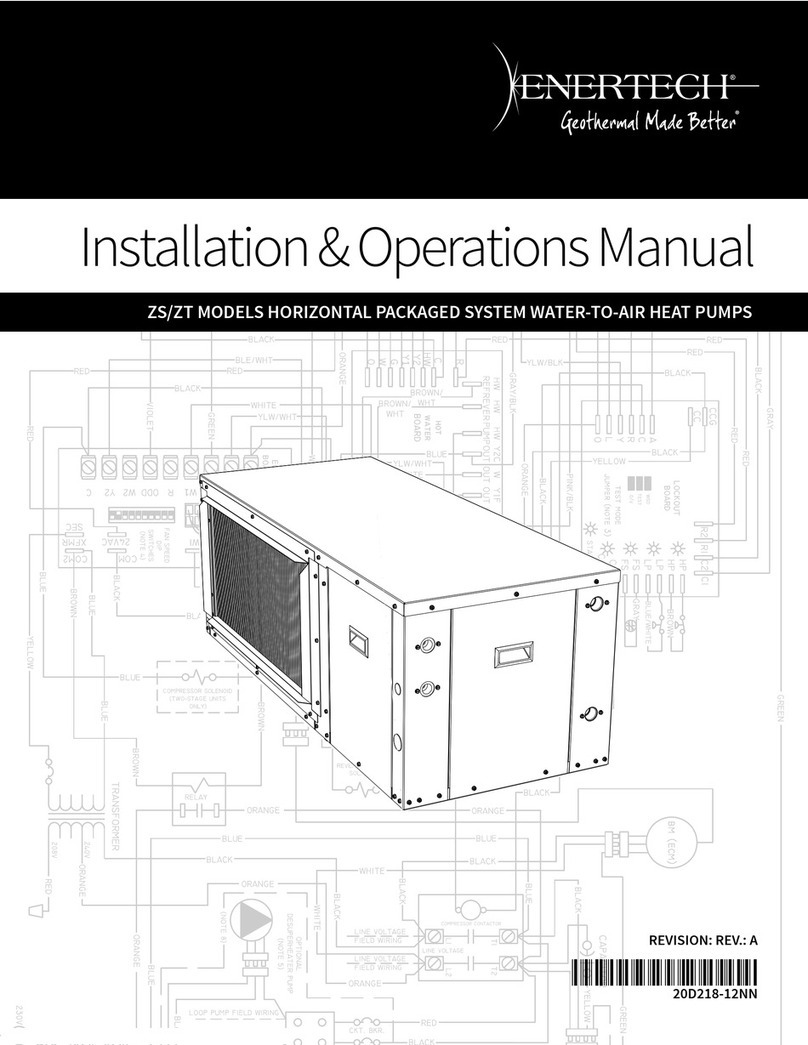
Enertech
Enertech ZS. User manual

Enertech
Enertech VC Series Instruction manual
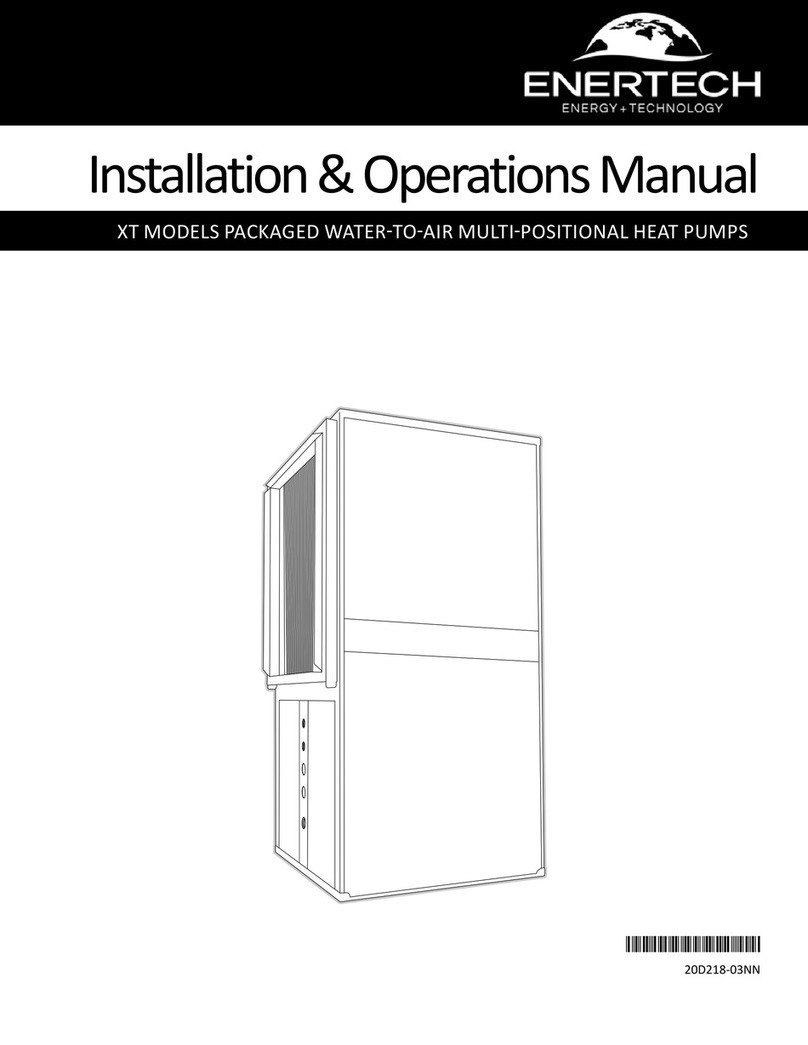
Enertech
Enertech XT Series User manual
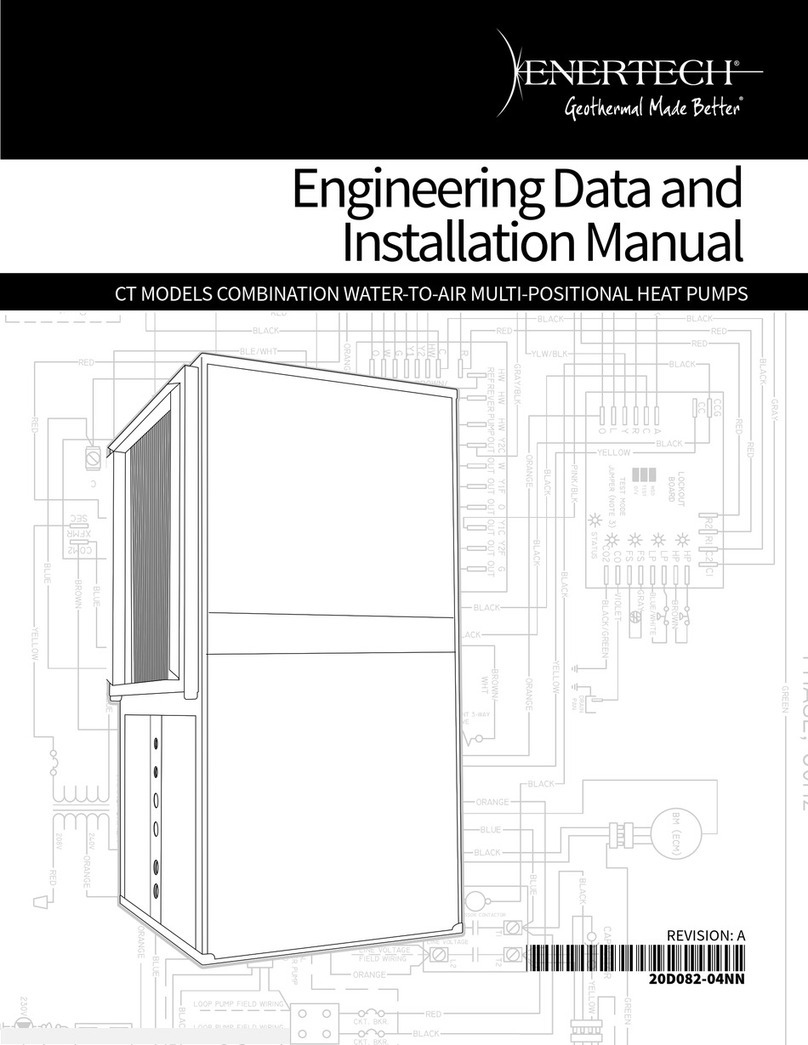
Enertech
Enertech CT024 Instruction manual
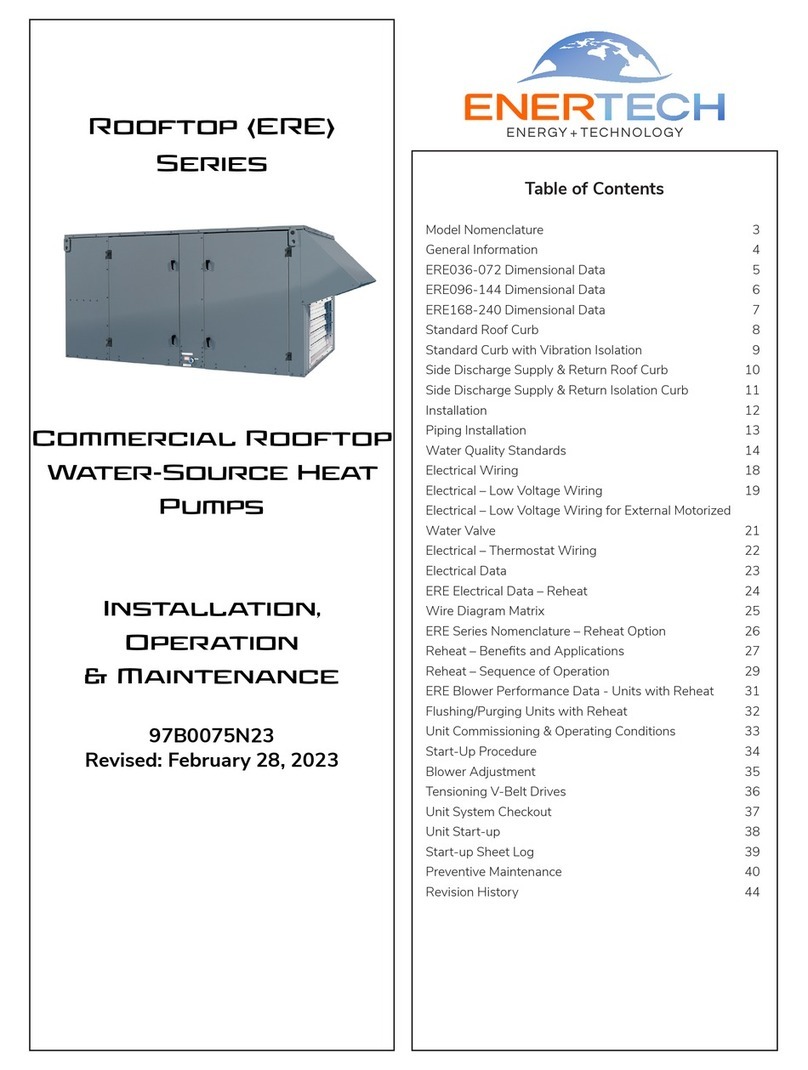
Enertech
Enertech ERE Series Owner's manual

Enertech
Enertech AV Series User manual

Enertech
Enertech EAV Series User manual
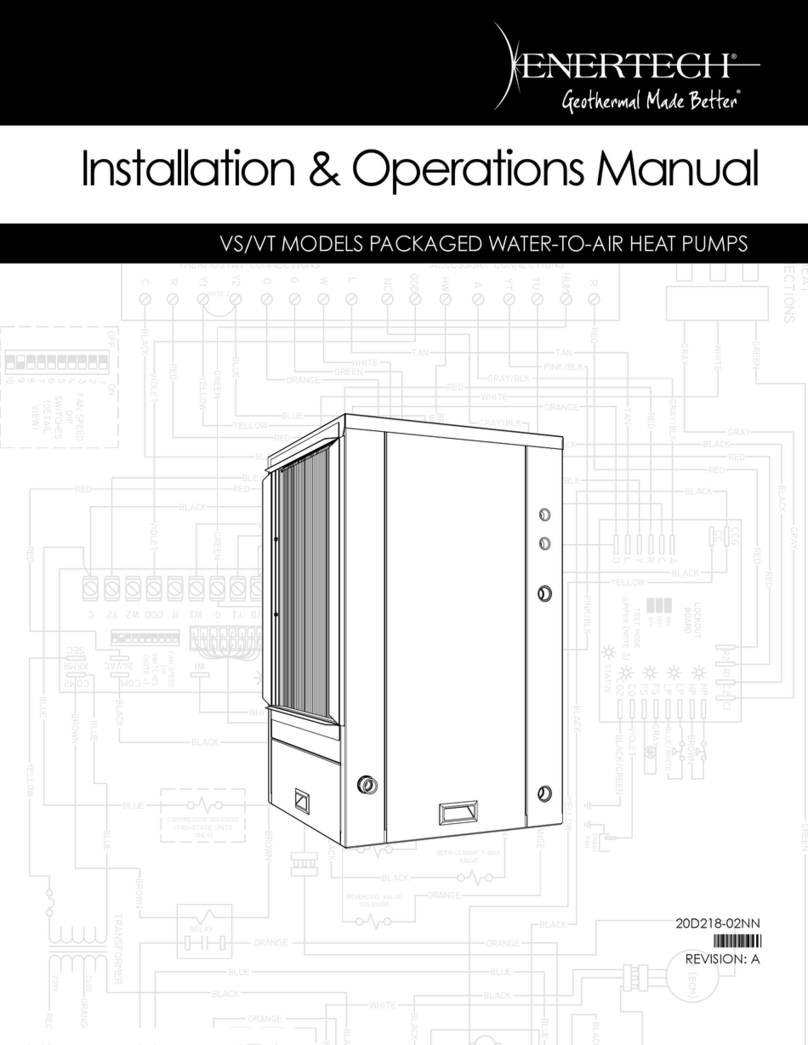
Enertech
Enertech VS Series User manual
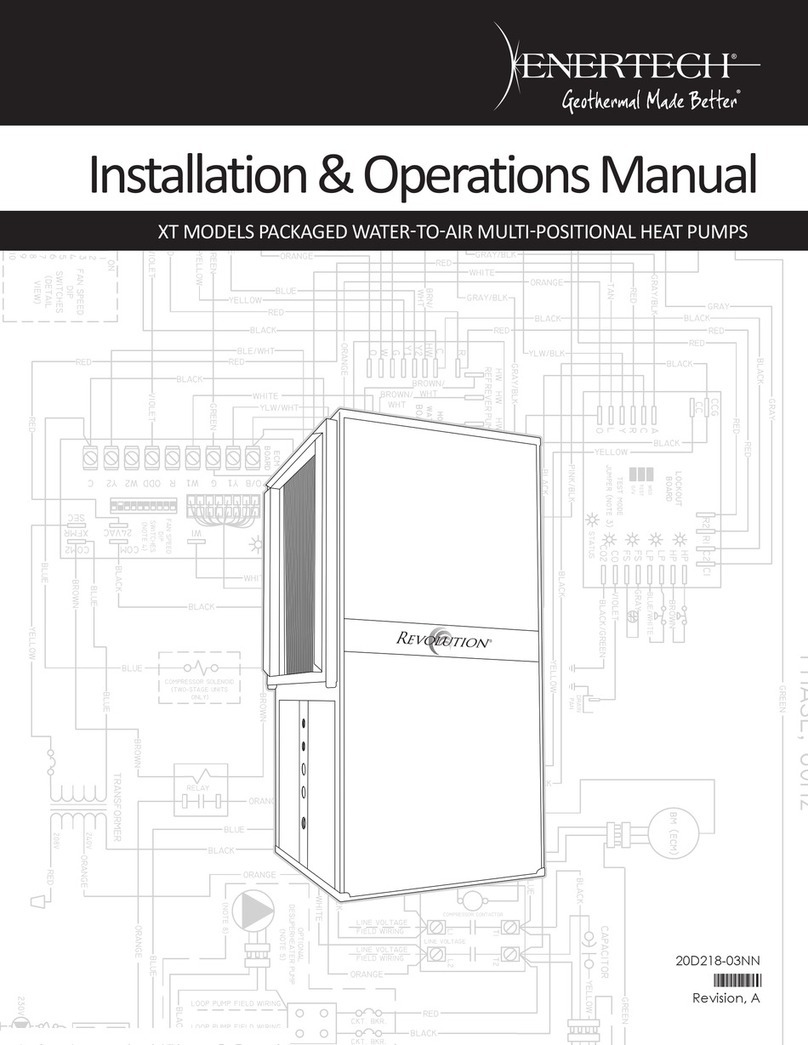
Enertech
Enertech XT024 User manual
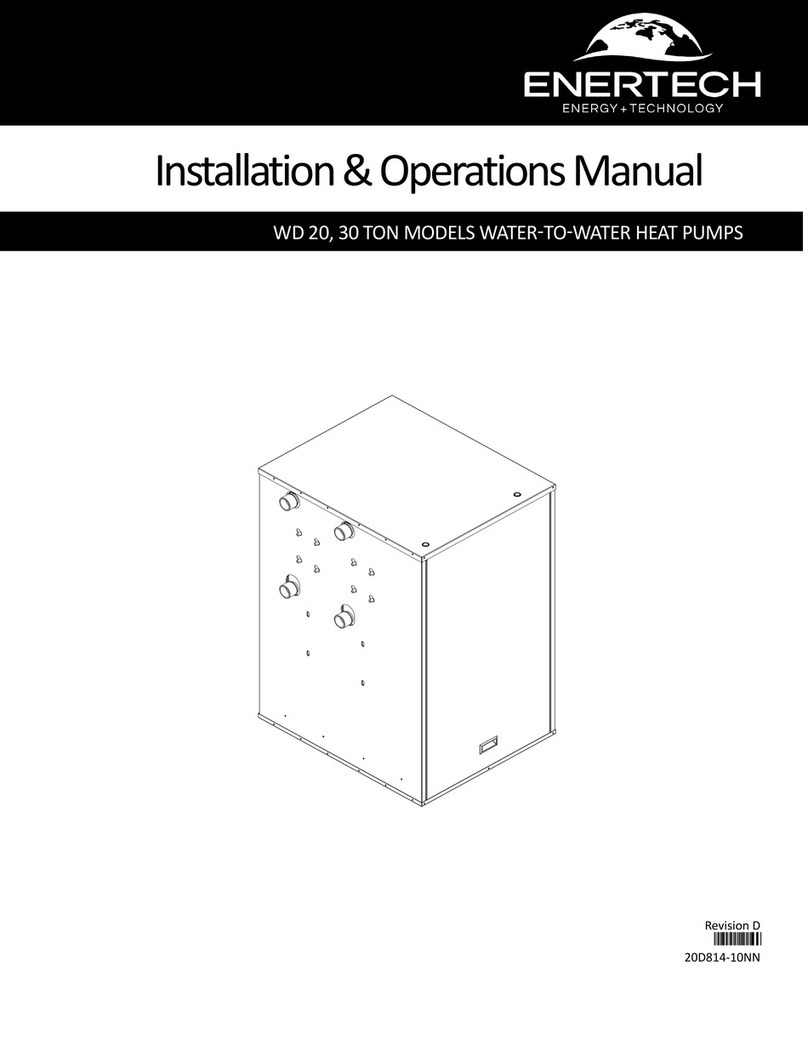
Enertech
Enertech WD240 User manual
